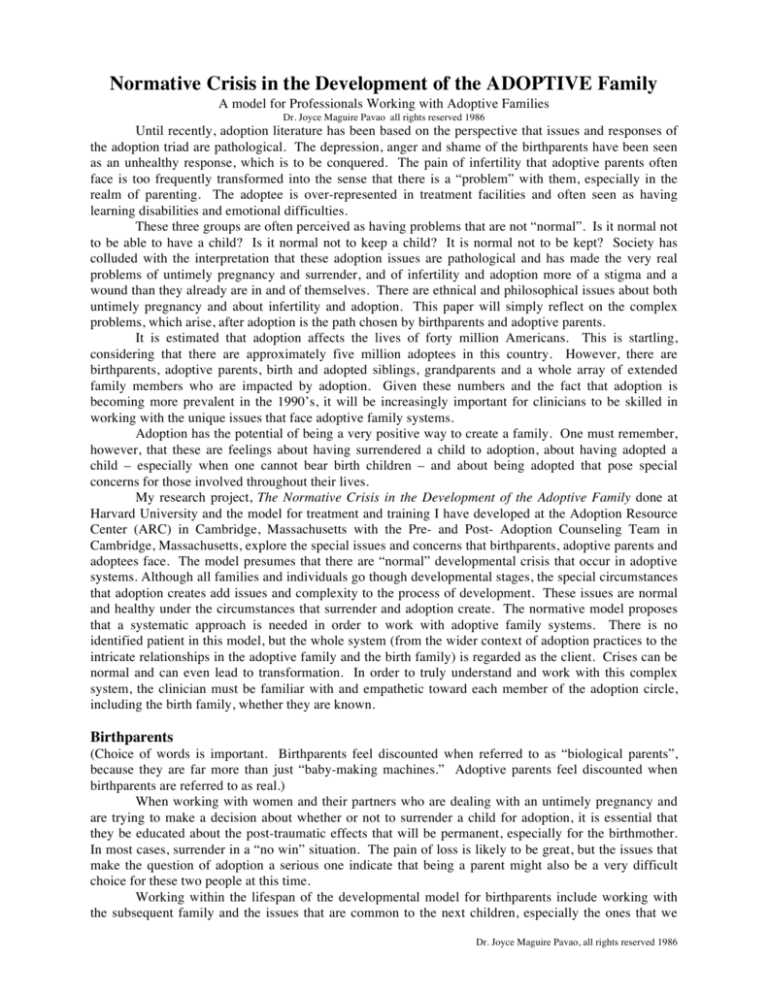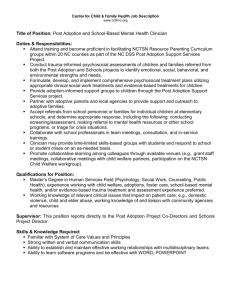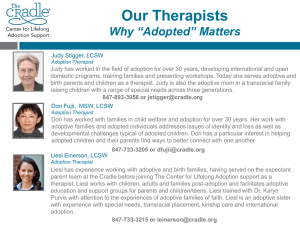
Normative Crisis in the Development of the ADOPTIVE Family
A model for Professionals Working with Adoptive Families
Dr. Joyce Maguire Pavao all rights reserved 1986
Until recently, adoption literature has been based on the perspective that issues and responses of
the adoption triad are pathological. The depression, anger and shame of the birthparents have been seen
as an unhealthy response, which is to be conquered. The pain of infertility that adoptive parents often
face is too frequently transformed into the sense that there is a “problem” with them, especially in the
realm of parenting. The adoptee is over-represented in treatment facilities and often seen as having
learning disabilities and emotional difficulties.
These three groups are often perceived as having problems that are not “normal”. Is it normal not
to be able to have a child? Is it normal not to keep a child? It is normal not to be kept? Society has
colluded with the interpretation that these adoption issues are pathological and has made the very real
problems of untimely pregnancy and surrender, and of infertility and adoption more of a stigma and a
wound than they already are in and of themselves. There are ethnical and philosophical issues about both
untimely pregnancy and about infertility and adoption. This paper will simply reflect on the complex
problems, which arise, after adoption is the path chosen by birthparents and adoptive parents.
It is estimated that adoption affects the lives of forty million Americans. This is startling,
considering that there are approximately five million adoptees in this country. However, there are
birthparents, adoptive parents, birth and adopted siblings, grandparents and a whole array of extended
family members who are impacted by adoption. Given these numbers and the fact that adoption is
becoming more prevalent in the 1990’s, it will be increasingly important for clinicians to be skilled in
working with the unique issues that face adoptive family systems.
Adoption has the potential of being a very positive way to create a family. One must remember,
however, that these are feelings about having surrendered a child to adoption, about having adopted a
child – especially when one cannot bear birth children – and about being adopted that pose special
concerns for those involved throughout their lives.
My research project, The Normative Crisis in the Development of the Adoptive Family done at
Harvard University and the model for treatment and training I have developed at the Adoption Resource
Center (ARC) in Cambridge, Massachusetts with the Pre- and Post- Adoption Counseling Team in
Cambridge, Massachusetts, explore the special issues and concerns that birthparents, adoptive parents and
adoptees face. The model presumes that there are “normal” developmental crisis that occur in adoptive
systems. Although all families and individuals go though developmental stages, the special circumstances
that adoption creates add issues and complexity to the process of development. These issues are normal
and healthy under the circumstances that surrender and adoption create. The normative model proposes
that a systematic approach is needed in order to work with adoptive family systems. There is no
identified patient in this model, but the whole system (from the wider context of adoption practices to the
intricate relationships in the adoptive family and the birth family) is regarded as the client. Crises can be
normal and can even lead to transformation. In order to truly understand and work with this complex
system, the clinician must be familiar with and empathetic toward each member of the adoption circle,
including the birth family, whether they are known.
Birthparents
(Choice of words is important. Birthparents feel discounted when referred to as “biological parents”,
because they are far more than just “baby-making machines.” Adoptive parents feel discounted when
birthparents are referred to as real.)
When working with women and their partners who are dealing with an untimely pregnancy and
are trying to make a decision about whether or not to surrender a child for adoption, it is essential that
they be educated about the post-traumatic effects that will be permanent, especially for the birthmother.
In most cases, surrender in a “no win” situation. The pain of loss is likely to be great, but the issues that
make the question of adoption a serious one indicate that being a parent might also be a very difficult
choice for these two people at this time.
Working within the lifespan of the developmental model for birthparents include working with
the subsequent family and the issues that are common to the next children, especially the ones that we
Dr. Joyce Maguire Pavao, all rights reserved 1986
refer to as the “second first child” – the one born “first” after the surrendered child. For older birthparents
who surrendered a child many years ago, there are several stages of treatment, including psychoeducation, confronting the shame, allowing the anger, acknowledging and grieving the loss, and finally
empowering and accepting stages which are crucial to the mastery and emotional development that is
often arrested at the time of surrender. In addition, there are post-search issues created by either initiating
a search or being searched for by the adoptee.
For those who are able to work with young couples prior to surrender, it is useful to educate and
expose them to the experiences of those who have made this decision in the past and the birthparents who
have more recently surrendered. We have created group therapy with a clinician and a birthmother who
has attained some mastery and who can empathize and work with those who are starting out on this
painful journey. The possibility of open adoptions make the processing of these emotions an on-going
journey and not one that must be put aside for many years. Groups like Concerned United Birthparents
(CUB) and The Adoption Connection (TAC) can help by providing support and education.
Pre-Adoptive Couples
The majority of pre-adoptive couples have been struggling for years with the issues of infertility.
The pain and loss that result from constantly hoping for a birth child and the invasive experiences of
medical, pharmacological and surgical procedures, as well as the strain on a couple’s relationship that
these produce make the process of adoption seem like more hoops to jump through in order to attain their
goal to be parents. Just like the birthparents, the adoptive parents feel like victims of the situation.
Birthparents are victims of untimely pregnancy and lack of support from a partner, family and society.
The result is a lifelong experience of pain, shame, guild, and loss. Most pre-adoptive parents are victims
of the situation of infertility, lack of understanding by some family and friends, and society, often also
resulting in a lifelong experience of pain, guilt, shame and loss – a portion of which may seemingly
“fixed” by adoption. Of course, adoption does not “fix” infertility. It does, however, make available the
experience of parenting.
Pre-adoptive couples are subject to a variety of stresses that others do not experience in parenting,
i.e. agency assessments and home studies, processing the variety of types of adoption includes varying
degrees of openness and having to make choices that will affect the rest of their lives, often while lacking
support and information from people who understand their process. Groups like Resolve and The
Adoption Connection can provide support and education about these issues.
Couples need education about the varying degrees of openness and the variety of types of
adoption, because they are making choices with lifelong implications. Couples are often quite surprised
to hear that just as in a marriage in which the in-laws and families are present (like a Greek chorus)
whether they live next door or 3,000 miles away, so in adoption are the birthparents and birth families
present in the lives of the adoptees, whether the adoption is a closed or open one. The education of the
pre-adoptive couple about the issues of adoption and how they affect the whole family (birth and
adoptive), about the kind of adoption that is best for them and about the empowerment that is so
important for them to be strong and caring parents are components of this very specialized clinical work.
Adoptive Families
There are ongoing issues in adoption for the whole family: how to tell the child, what to tell the
child, when to tell the child, how to deal with extended family members and neighbors, how to work with
the schools and with professionals who have little or no experiences with learning disabilities, attention
deficit disorder and emotional difficulties in adopted children. Things that birth families take for granted
may pose serious dilemmas for adoptive families. One example is medial history – physicians say that
dealing with an adoptee is like dealing with a coma victim in the sense that critical and current family
history information is often missing and impossible to get.
In adolescence, a variety of issues emerge for the adoptee and for the adoptive family. Adoptees, like all
adolescents. Begin to look at themselves more carefully. For the adoptee, looking in the mirror may lead
to the realization that he/she does not know another human being in the world that is related to him/her.
The fact of adoption complicates issues of identity, sexuality, trust, self-esteem and individuation, to
name just a few.
Dr. Joyce Maguire Pavao, all rights reserved 1986
As adolescence brings on a search for identity, adoptive parents are often faced with the
confusing task of how to help the child integrate a complete sense of self when pieces of his/her heritage
may be problematic or even missing entirely. Simultaneous with the adolescent doing his/her search, the
adoptive parents are often subconsciously or consciously dealing again with the issues of lose, wondering
what their birth-child might have been like and about the preparation for their adopted child’s move
toward adulthood and intense feelings about the loss of this child, who will soon be an adult.
There are also effects on the adoptees and the family if the search for birthparents in undertaken.
The search brings up issues of conflicting loyalties for the adoptee between the adoptive parents and the
birthparents. It also brings up fear and fantasies for everyone that is often difficult to manage. It is at this
time that issues of loss arise again for all members of the adoption circle. For the adoptee there is fear of
loss of and rejection by the adoptive family and possible rejection by birthparents. Adoptive parents must
confront the fear of losing the adoptive child to the birth family, and the birth parents have the pain and
loss associated with surrender brought back into their lives. It is important to note that although search
brings up difficult and painful issues, it is an integral part of the healing process of identity and intimacy
that is essential to making whole all of these broken connections. Clinicians must understand the
importance and intricacies of the search and recognize that it is a healing journey no matter what is found.
There are also issues regarding the adoptee as parent, the birthparents’ future parenting, the complexities
(and concrete possibilities) of open adoption, the myriad of reproductive technologies and the issues of
adoption that are present for generations, as we look at family histories through genograms with a family
system approach.
Adoption is an ongoing issue throughout the life cycle and beyond, affecting not only the
generations past but the ones to come as well. In consideration of the experiences of adoptive systems
throughout the lifespan, I have developed a therapeutic approach in my model called “brief long-term
therapy” in which a family and various constellations (family as a whole and different sub-systems) are
seen during a crisis and the work is in transforming the crisis into an empowering experience. Coming
back for further counseling at another point in the development of the family is not seen as failure, but as
a success in working through yet another stage of development. There is a completion of each stage of
therapy but no termination. The word “termination” is too loaded for those who have suffered the losses
associated with adoption – the loss of generational continuity and connection. The brief long-term model
proposes that a therapist be available for consultation and therapy to each family in an ongoing fashion so
as to avoid the emotional cut-off and loss that are primary issues in adoption.
An approach that incorporates “normative crisis” allows us, as professionals, to see the difficult
times in a way that is not based in pathology. This creates opportunities for clinicians to act in ways that
lead to the empowerment of individuals and families affected by the issues of adoption. Work with the
larger system, the professionals, schools, courts and agencies are also a part of the model, which is a
model of training as well as treatment.
Dr. Joyce Maguire Pavao, all rights reserved 1986






